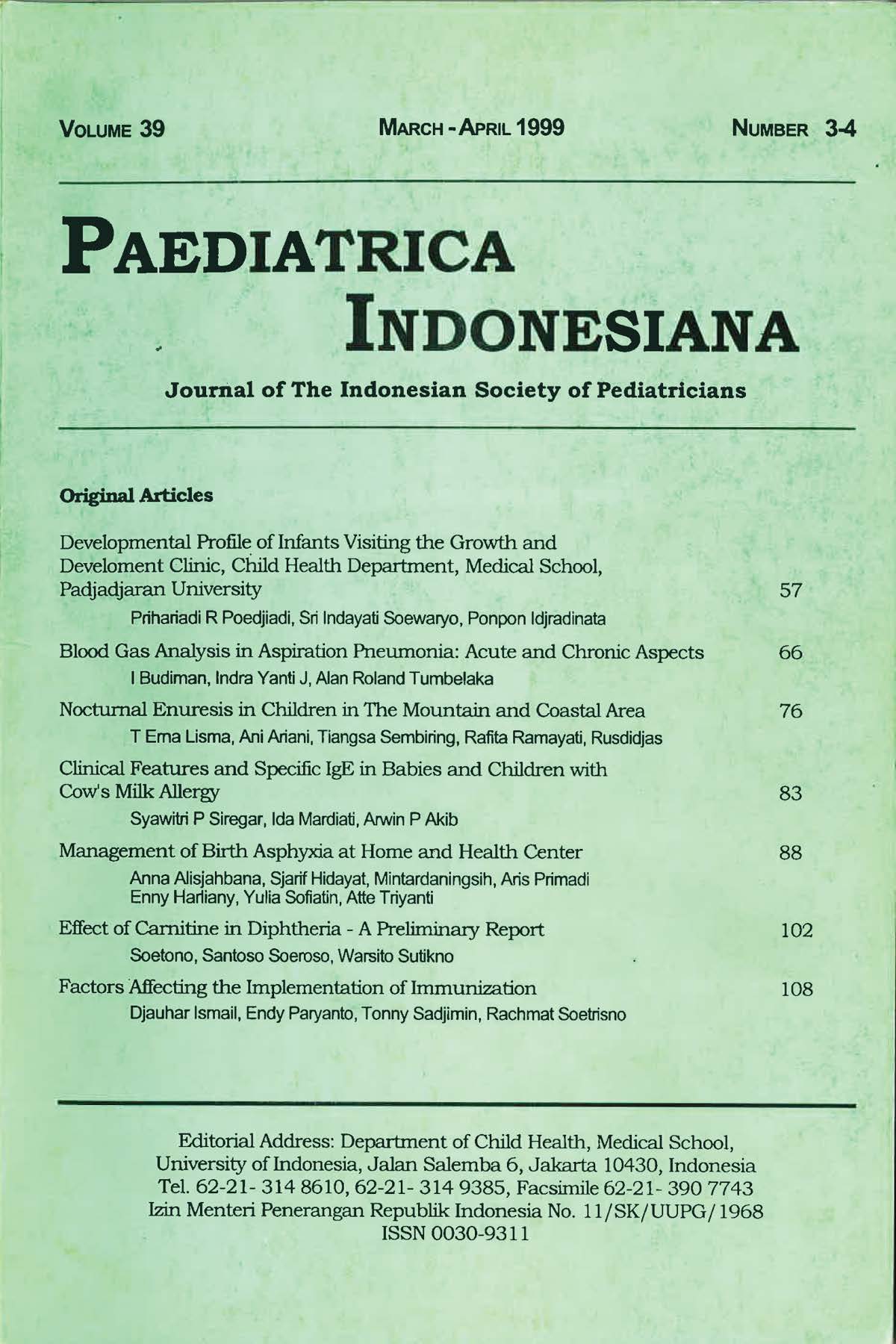Developmental Profile of Infants Visiting the Growth and Development Clinic, Child Health Department, Medical School, Padjadjaran University
DOI:
https://doi.org/10.14238/pi39.3-4.1999.57-65Keywords:
developmental profile, congenital deviation, nutritional status, Index of Mental Development, IPM, Index of Psychomotor Development, IPPAbstract
Development of a child is the result of a continuous interaction betweenbiological factor serving as basis and the environment that gives stimulation. Indonesia as a developing country has an environmental characteristically different from that of advanced countries such as USA, where the Bayley developmental test tool was constructed, so that as an initial step in order to find out how far the level of development of the Indonesian child in general was, a study was made on the level ol
developmental of healthy 18-month-old infants visiting the Growth & Development Clinic in the Child Health Department of Dr. Hasan Sadikin General Hospital Bandung. Thirty healthy infants were chosen comprising 19 (63%) male and 11 (37%) female infants who were born nonnally without any congenital deviation, with good nutritional status, not anemic, never been hospitalized and had a good physical status during the study period. This study yielded an average Index of Mental Development
(IPM) of 124.2 (6.94) and an index of Psychomotor Development (IPP) of 110.7 (6.16). The resulting IPM and IPP were higher compared to the notmal Bayley scale for 18-month-old infants (p<0.0001). This could be due to the absence of several biological risk factors in the subjects and to the sullicient amount of a ttention given by all members of the family so that the child developed well.
References
2. Njiokkiktjien c. Pediatric behavioral neurology, 1st ed. Suyi Pub!, Netherlands, 1988: 24-33.
3. Illingworth RS. The normal child, lOth ed. Edinburg: Churchill Livingstone, 1991: 127-38.
4. Aylward GP. The relationship between environment risk and development outcome. J Dev Behav Pediatr 1992;13:3-20.
5. Cohen SE, Parmellee A, Beckwith A, ~igman M. Cognitive development in preterm infants: birth to 8 years. J Dev Behav Pediatr 1986, 17;2: 102-5.
6. FrankenbUJ& WK. Developmental assessment, infant and preschool developmental screening. In: Levine, William, Allen, editors. Developmental behavioral pediatrics. Philadelphia: Saunders, 1983: 927-37.
7. Casey PH, Bradley RH, Caldwell BM, Edward DR Development intervention; A pediatric clinical review . Peel Clin Amer 1986,133;4: 899-921.
8. Escalona SK. Babies at double hazard: Early development of infants at biologic and social risk. Pediatrics 1982;70: 670-6.
9. Sameroff AJ, Seifer R, Barocas Ret al. Intelligence quotient scores of 4-year-old children: social- environmental risk factors. Pediatrics 1987;79:343-9.
10. Gilbride KE. Developmental testing. Ped.iatr Rev 1995; 9: 338-44.
11. Ross G. Some thoughts on the value of infant tests for assessing and predicting mental ability. J Dev Behav Pediatr 1989;10;1:44-7.
12. Bayley N. Manual for the Bayley Scales of infant development New York The psychological corp, 1969;10-14.
13. Bradley RH, Caldwell BM, Elardo. Home environment and cognitive development in the first two years; a cross-lagged analysis. Devel Psychol1979; 15: 246-50.
14. Leib AS, Benfield GD, Guidubaldi J. Effects to early intervention and stimulation on the preterm infant. Pediatrics 1980;60: 83-9.
15. Van de Bor Metal. Early detection of delayed myelinisation in preterm infants. Pediatrics 1989;84: 407-11.
16. Resnick BM. Developmental intervention for low birth weight infants; improved early developmental outcome. Pediatrics 1987;180: 68-73.
17. Nelson KB, Ellenberg JH. Neonatal signs as predictors of cerebral palsy. Pediatrics 1979;64: 225-32.
18. Robertson C. Term infants with hypoxic-ischemic encephalopathy, outcome at 3.5 years. Devel Med Child Neuroll985;27: 473-8.
19. Lozoff 8, Brittenham GM, Wol AW. Iron deficiency anemia and iron therapy effect on infant developmental test performance. Pediatrics 1987;79;6:981-93.
20. ldjradinata PS. Akselerasi pertumbuhan dan optimasi perkembangan bayi anemia kekurangan besi dengan suplementasi besi. Disertasi: Universitas Padjadjaran.
21. Colombo M, Parta A. Intellectual and physical outcome of children undernourished in early life is influenced by later environmental conditions. Pediatrics 1992;34: 611-22.
22. Kaplan PS. Child Odyssey, 2nd ed. New York West Publishing Co. 1991;178-208.
23. Hoffman LW. Effects of maternal employment in two-parent family. Amer Psycho! 1989: 283-93.
24. Hurlock E. Motor development in child development, 8th ed. McGraw-Hill, Kogakusha LTD, 1978:146-50.
25. Harsojo. Kebudayaan Sunda. In: Koentjaraningrat ed. Manusia dan kebudayaan Indonesia. Jakarta: Djambatan 1971: 305-10.
26. Rusyana Y, Sariyun Y, Ekadjati ES, Darsa UA. Pandangan hidup orang Sunda; Seperti tercermin dalam kehidupan masyarakat dewasa ini. Departemen Pendidikan dan Kebudayaan Direktorat Jendral Kebudayaan, Direktorat Sejarah dan Tradisional. Proyek Penelitian dan Pengkajian Kebudayaan Nusantara 8agian Proyek Penelitian dan Pengkajian Kebudayaan Sunda, 1988: 116-20.
Downloads
Published
How to Cite
Issue
Section
License
Authors who publish with this journal agree to the following terms:
Authors retain copyright and grant the journal right of first publication with the work simultaneously licensed under a Creative Commons Attribution License that allows others to share the work with an acknowledgement of the work's authorship and initial publication in this journal.
Authors are able to enter into separate, additional contractual arrangements for the non-exclusive distribution of the journal's published version of the work (e.g., post it to an institutional repository or publish it in a book), with an acknowledgement of its initial publication in this journal.


















